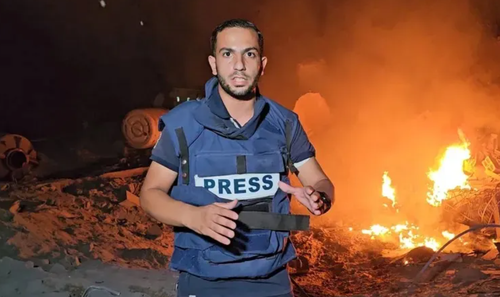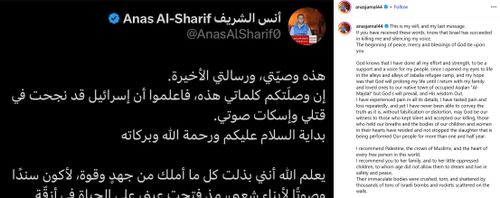Israel’s military has killed six journalists in a strike on Gaza City, after claiming one of them was the head of a Hamas cell.
Qatari broadcaster Al Jazeera said four of its journalists were killed in the strike, including Anas Al-Sharif, who was accused of leading the cell.
Mohammed Qreiqeh, another prominent Al Jazeera journalist in Gaza, was also killed in the strike, the network said.

“The order to kill Anas Al-Sharif, one of Gaza’s bravest journalists, along with his colleagues, is a desperate attempt to silence voices ahead of the occupation of Gaza,” Al Jazeera said in a statement after the attack.
Palestinian journalists’ groups condemned the killings.
A press freedom group and a UN expert previously warned that Al Sharif’s life was in danger due to his reporting from Gaza.
UN Special Rapporteur Irene Khan said last month Israel’s claims against him were unsubstantiated.
In July, the Committee to Protect Journalists urged the international community to protect Al Sharif.
After his death, Al-Sharif’s Instagram account posted his “will and last message”.
“If you have received these words, know that Israel has succeeded in killing me and silencing my voice,” the post read.
“I advise you not to be silenced by the restrictions, and to be bridges towards the liberation of the country and its slaves, so that the sun of dignity and freedom may shine on our poor country.”

Al-Sharif was in a tent with other journalists near the entrance to the Al-Shifa Hospital when he was killed, according to hospital director Dr Mohammad Abu Salmiya.
The strike killed at least seven people, Salmiya said.
The Israel Defence Forces (IDF) accused Al-Sharif of leading a Hamas cell that “advanced rocket attacks against Israeli civilians and IDF troops”.
The IDF had previously shown documents it claimed showed “unequivocal proof” of Al-Sharif’s ties to Hamas.
“The IDF had previously disclosed intelligence information and many documents found in the Gaza Strip, confirming his military affiliation to Hamas,” the military said in a statement after the strike.
Last month, after the IDF accused Al-Sharif of being a member of Hamas, he responded in a message on social media.
“I reaffirm: I, Anas Al-Sharif, am a journalist with no political affiliations. My only mission is to report the truth from the ground — as it is, without bias,” he wrote.
“At a time when a deadly famine is ravaging Gaza, speaking the truth has become, in the eyes of the occupation, a threat.”
The Committee to Protest Journalists (CPJ) said in July they were “gravely worried” for Al-Sharif’s safety and that the journalist feared for his life after he was the target of “an Israeli military smear campaign, which he believes is a precursor to his assassination”.
Since the beginning of the war nearly two years ago, CPJ says 186 journalists have been killed in Israeli strikes.
The United Nations also called Israel’s charges against Al-Sharif “online attacks and unfounded accusations.”
“I am deeply alarmed by repeated threats and accusations of the Israeli army against Anas Al-Sharif, the last surviving journalist of Al Jazeera in northern Gaza,” Irene Khan, the UN Special Rapporteur on freedom of expression, two weeks ago, said.
Al-Sharif, who was married and had two children, had prepared a final message in the event of his death which was shared by his colleagues.
“I urge you not to be silenced by chains, nor to be hindered by borders, and to be bridges towards the liberation of the land and its people, until the sun of dignity and freedom shines upon our occupied homeland,” Al-Sharif wrote.






